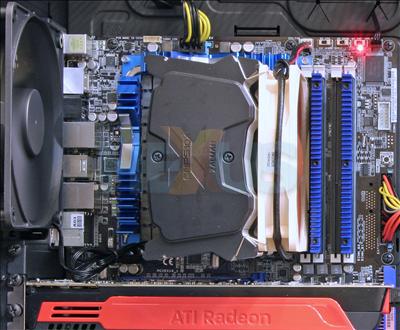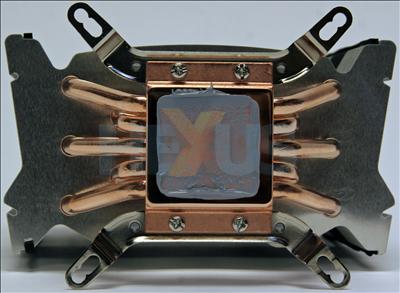Zalman CNPS10X Flex - Installation and performance
Along with the Scythe Kabuto, the Zalman CNPS10X Flex doesn't have T.I.M. pre-applied to speed installation, instead it comes with a syringe of ZM-STG2 thermal grease. Unfortunately, the supplied grease is a thick stodgy substance that defies being spread evenly.
Normally this could be worked around by the use of a spreader card which some manufacturers provide, or alternatively an old credit card, however this grease is so stodgy it just sticks to that as well. The only methods we can suggest you use when applying the grease to the cooler are either (a) put a large blob in the middle and hope it spreads evenly under pressure, or (b) dab it on carefully with your finger. We utilised the latter approach and managed to achieve something close to an even finish.
Unlike the other coolers on test which require the fitting of a specific retention frame/backplate, the Zalman ingeniously makes do with just one for all the supported CPU's. However, like the Corsair H50, the installation process can be a bit fiddly due to the number of parts that need to be fitted to the backplate and cooler in order to prepare it for installation. Of course, it'll take even longer if the chassis you're using doesn't have the appropriate cutout on the back of the motherboard tray.
The first step in the installation of this cooler is to attach the appropriate CPU clips (Intel or AMD). Once done, the four nuts get inserted through the relevant holes in the retention backplate and are then secured by sliding over the side-caps. Then attach either the plastic loading block, or square double-sided sticky pad to the retention backplate as appropriate. Finally attach the retention backplate to the underside of the motherboard, using either the remaining double-sided tape on the loading block, or the square double-sided sticky pad, being careful to align it squarely against the four holes in the motherboard around the CPU socket.
Like the self-adhesive pads supplied with the Corsair H50 to secure the backplate to the motherboard, the plastic loading block and square double-sided sticky pad will only be suitable for one application and at present Zalman doesn't seem to sell spares to cater for subsequent installations.
The cooler can now be mounted on the CPU and is secured by screwing the supplied bolts through the appropriate holes in the CPU clips on the cooler and into the retention backplate. The final part of the installation process is to mount the anti-vibration shims onto the cooler, and then attach fan(s) (not supplied) using the supplied clips. These utilise a simple torsion-beam design and are a bit fiddly to install.
When utilising just one fan Zalman recommends having the fan blow through the cooler toward the rear chassis fan and this is how we tested it. When utilising two fans, we had both configured to exhaust hot air toward the rear chassis fan.
As can be seen in the image above, due to the size of the cooler and the way the fans mount onto it, the first DIMM slot can be blocked by the cooler-attached fan. Similarly, on some motherboards, the first PCIe x16 slot will also be blocked.
Although installation was trouble-free due to the flexibility of the Corsair 800D chassis, uninstalling the cooler first required the removal of both fans in order to access the bolts to unscrew it from the CPU.
Performance
| Zalman
CNPS10X Flex - Thermal performance stock speed |
||||
|---|---|---|---|---|
| System state | Idle (1-fan) |
Idle (2-fans) |
Load (1-fan) |
Load (2-fans) |
| Ambient temperature | 23.1°C | 23.1°C | 23.7°C | 23.8°C |
| Case temperature | 24.5°C | 24.7°C | 27°C | 27.3°C |
| Ambient/Case delta | 1.40°C | 1.60°C | 3.30°C | 3.50°C |
| CPU temperature | 28°C | 27°C | 58°C | 56°C |
| CPU/Case delta | 3.50°C | 2.30°C | 31.00°C | 28.70°C |
| CPU/Ambient delta | 4.90°C | 3.90°C | 34.30°C | 32.20°C |
| Zalman
CNPS10X Flex - Thermal performance overclocked |
||||
|---|---|---|---|---|
| System state | Idle (1-fan) |
Idle (2-fans) |
Load (1-fan) |
Load (2-fans) |
| Ambient temperature | 23.6°C | 23.5°C | 24.2°C | 23.7°C |
| Case temperature | 26°C | 25.1°C | 27.6°C | 27.1°C |
| Ambient/Case delta | 2.40°C | 1.60°C | 3.40°C | 3.40°C |
| CPU temperature | 38°C | 36°C | 76°C | 71°C |
| CPU/Case delta | 12.00°C | 10.90°C | 48.40°C | 43.90°C |
| CPU/Ambient delta | 14.40°C | 12.50°C | 51.80°C | 47.30°C |
With just one quiet Noctua NF-P12 fan installed, the performance delivered by Zalman's CNPS10X Flex is pretty impressive.
With two quiet NF-P12 fans installed, the performance goes up a notch and gives the Corsair H50 a run for its money.
As with the other coolers on test, during thermal testing the fans were set to run at 100 per cent. However, as the Noctua fans are only three-pin they don't support the PWM function required to use the motherboards CPU fan header controls, so instead they were fitted with the supplied low-noise adapters to check low-noise operation after the thermal testing had concluded.
Even when running at 100 per cent, the fans only spin at around 1,400 rpm and are fairly quiet. With the low-noise adapters fitted, the fan speed drops to around 1,100 rpm and the fans are almost silent in operation.














